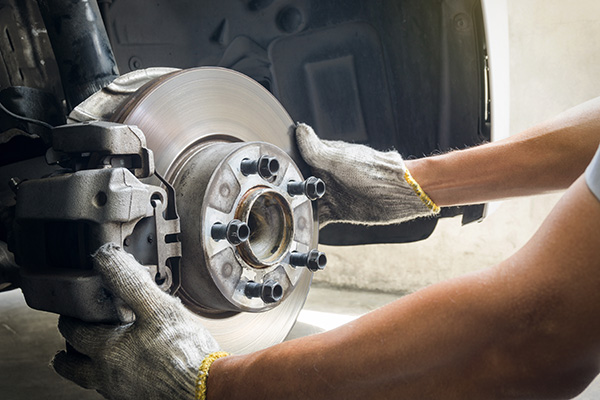
Brakes rarely go from fine to failing in one day. They whisper first. A pedal feels a touch lower at stoplights, a faint squeak shows up in the morning, or the wheel shudders a little on a downhill exit ramp.
If you pick up on these early changes, you can fix a small issue before it turns into warped rotors, seized calipers, or a longer-than-expected stop.
1. Pedal Feel Is Not What It Used To Be
Your foot knows your car. When the pedal starts to travel farther or feels softer when you hold steady pressure, something has changed in the hydraulic system. Air trapped in a line, moisture in old fluid, or a master cylinder that is beginning to bypass can all make the pedal feel spongy. If the pedal sinks slowly at a red light, that is a sign to park the car and schedule service, since internal leaks will not heal themselves.
2. New Noises That Do Not Fade
A light squeal on the first few stops of the day can be normal when moisture flashes off the rotors. Persistent noises are different. High pitched squeaking often comes from the wear indicators that are built into the pads. Grinding or a rough scrape points to pads that have worn down to the backing plates and are now cutting into the rotors. The sooner you catch a squeak, the more likely you are to save the rotors and avoid extra parts.
3. Pulling, Pulsing, or a Shake in the Wheel
If the car pulls to one side when braking, one caliper may be sticking or one hose may be restricted. A pulsing pedal or a shake in the steering wheel suggests rotor thickness variation. Heat spots and uneven pad deposits can create this feel long before rotors are truly warped. Ignoring the shake wears tires faster and stresses suspension bushings. A road test and rotor runout check tell you whether a simple resurface or a replacement makes more sense.
4. Warning Lights, Smells, and Hints You Can Miss
A brake warning light can mean several things depending on the car. Low fluid in the reservoir, a worn pad sensor, or a fault in the ABS unit can all turn the light on. A hot, acrid smell after a drive hints at a dragging caliper or a parking brake that did not release completely. If you see brake fluid on the inside of a wheel, or dampness along a brake line, that leak needs attention now. Fluid is the link between your foot and the calipers. Any loss reduces braking force.
5. Stopping Distance Creeps Up
Drivers often notice they are pressing the pedal a little earlier than last month. That small change points to pads that have glazed, fluid that has absorbed moisture, or a booster vacuum issue that appears only when idle. If the ABS activates more often than usual in routine stops, the tires may be losing grip early, or the system is compensating for uneven braking side to side. Either way, the system is telling you to take a closer look.
Quick Checks You Can Do at Home
- With the engine off and on level ground, check the fluid level. It should be near the MAX line and look clear to light amber.
- Look through the wheel spokes. If a pad looks very thin or a rotor is deeply grooved, the brakes are due.
- After a short drive, feel each wheel area carefully without touching hot parts. One corner is much hotter than the others, hinting at a dragging brake.
These checks do not replace an inspection, but they help you decide how soon to plan a visit.
Why Brake Problems Snowball When Ignored
Thin pads run hotter and shed more material, which lays unevenly on the rotor and creates that pulse you feel. Old fluid absorbs moisture and lowers the boiling point, which can turn into a soft pedal after a long downhill. A sticking caliper wears one pad into the backing plate, then overheats the rotor and the wheel bearing next to it. Small issues compound quickly because heat accelerates wear throughout the system.
What a Proper Brake Inspection Includes
A good inspection measures pad thickness, rotor condition, and runout. Hoses are checked for cracking, and caliper slide pins are cleaned and lubricated so they move freely. Fluid moisture is tested, and the master cylinder and ABS unit are checked for leaks or stored faults. If the vehicle pulls, the shop road tests and compares the brake balance side to side. The goal is to use a firm, consistent pedal and even stop at all four corners.
Brake Service Options That Add Real Value
Fresh pads and quality rotors restore smooth stops. New hardware and properly lubricated slides keep wear even. Fluid replacement every two to three years removes moisture and protects calipers, valves, and ABS components. If you tow, drive in the hills, or commute in heavy traffic, talk about pad compounds that handle heat better without extra noise. The right parts and procedures make a big difference in pedal feel and longevity.
Restore Confident Braking with Allen Automotive in Silver Spring, MD
If your pedal feels different, if a new noise will not fade, or if the wheel shakes on a downhill ramp, bring your car to Allen Automotive in Silver Spring. We will measure pad and rotor life, test fluid moisture, free up any sticking hardware, and give you a clear plan with options that fit your budget.
Call or stop by today so your next stop is smooth, straight, and predictable on every drive.